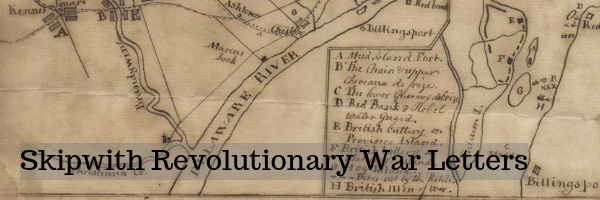The Skipwith Revolutionary War Collection consists primarily of the papers of Nathanael Greene, Major-General of the Continental Army. During the latter years of the war, Greene commanded the Southern Army, which had suffered from weaker commanders.
Materials in this collection were donated by Kate Skipwith, a descendant of Greene. Primarily, materials include correspondence from important Revolutionary figures, such as George Washington, John Hancock, Thadeus Kosciuszko and others to General Greene. Topics in these letters include reports of Native American involvement in the War, troop morale, battle descriptions, troop movements and more. Other notable items in this collection include a sheet of Continental currency, a 1777 hand-drawn map of Philadelphia operations, and portraits of Revolutionary figures.
-

George Washington
D. Appleton and Co.
Portrait of George Washington, facing right. Includes facsimile of Washington's signature.
-

Kosciuszko
G. P. Putnam and Co.
Portrait of Kosciuszko, facing left. Includes facsimile of Kosciuszko's signature.
-

Brigadier General Anthony Wayne
Author Unknown
Portrait of Brigadier General Wayne, facing right. Includes facsimile of Wayne's signature.
-

Brigadier General Isaac Huger, 1743-1797
Author Unknown
A portrait of Brigadier General Huger, facing right, wearing a hat and cloak.
-

Henry Lee
Author Unknown
Portrait of Henry Lee, facing right. Includes facsimile of Lee's signature.
-

Impression of George Washington's Seal
Author Unknown
Impression of George Washington's seal in wax on paper.
-

Major General Nathaniel Greene
Author Unknown
Portrait of Major General Greene, facing left. Includes facsimile of Greene's signature.
-

Robert R. Livingston
Author Unknown
Portrait of Robert R. Livingston, facing left. Includes facsimile of Livingston's signature.
-

L. Tucker to Cornelia L. Littlefield (31 March 1824)
L. Tucker and Cornelia L. Littlefield
Lillia Skipwith Tucker (daughter of Sir Peyton Skipwith, baronet, of Mecklenburg County, VA/ Prestwould Plantation and his first wife, Ann Miller), writes to her sister-in-law, Cornelia L. Littlefield. Lillia married first George Carter and then St. George Tucker, and Cornelia was married to Lillia's brother Peyton (her second marriage). Lillia's is a life with many medical hardships, both her own and those of her family and friends. She asks for news of other family members.
-

Nathanael Greene to the Inhabitants of Baltimore (September 1783)
Nathanael Greene
Greene is flattered by the kindness of the people of Baltimore upon his return from the front lines.
-

Resolution of the Senate of South Carolina (12 August 1783)
Francis Sharp
Resolution of the Senate of South Carolina commending Greene for his service in the Southern department, to be presented by the Governor, signed by Francis Sharp, President of the Senate of South Carolina.
-

George Washington to Nathanael Greene (29 January 1783)
George Washington and Nathanael Greene
Washington discusses possible scenarios concerning British capture of territory; continues by discussing his interest in the upcoming discussion in between Parliament and King George III as well as Richard Oswald's use of the phrase United States of America
-

Nathanael Greene to David Oliphant (21 December 1782)
Nathanael Greene and David Oliphant
Greene authorizes Oliphant to grant forage for the Army's General Hospital.
-

Thad Kosciuszko to Nathanael Greene (18 November 1782)
Tadeusz Kosciuszko and Nathanael Greene
Kosciuszko recounts the Battle of James Island (S.C.) [referenced in the letter as John's Island] where the Patriots were outnumbered by the British, and where Capt. [William] Willmott was mortally wounded.
-

David Ramsay to Nathanael Greene (9 June 1782)
David Ramsay and Nathanael Greene
Ramsay acknowledges that Greene's unit would be in better spirits if they had more to keep them busy. He reports discussions from Congress about supplies, recent developments near Jamaica, and updates on various familiar names. He also mentions the popularity of George Washington.
-

Count de Rochambeau to Nathanael Greene (26 June 1782)
Jean-Baptiste Donatien de Vimeur Rochambeau, comte de and Nathanael Greene
Rochambeau relays the poor reception of Carleton's proposition to the Congress, discusses details of intelligence, and announces the intent of the French to join forces with General Washington in New York.
-

Anthony Wayne to Nathanael Greene (24 June 1782)
Anthony Wayne and Nathanael Greene
Wayne reports a battle between Col. Posey's battalion and a large number of Creek Indians who had combined forces with the British Army to conduct a surprise attack. The battalion held its own, and won several British trophies, mostly horses, but did lose a number of men in Cavalry, Infantry, and Artillery.
-

Arthur Campbell to Nathanael Green (2 August 1781)
Arthur Campbell and Nathanael Greene
Campbell reports a pacific disposition among those forming the treaty, and expects that the Mountain Militia will soon be able to redeploy their resources toward Greene's position. He suggests that Continental Garrisons be erected in Indian territory along with land transfer as punishment for their aggression.
-

Arthur Campbell to Nathanael Greene (8 February 1781)
Arthur Campbell and Nathanael Greene
Colonel Campbell reports the defection of Cherokee Indians from the American interests, and the conditions of the Cherokee camps. He also includes a copy of his attempts at a peace negotiation. Major [Joseph] Martin is cited as the Agent of Indian Affairs for Virginia.
-

Isaac Huger to Nathanael Greene (8 February 1781)
Isaac Huger and Nathanael Greene
General Huger reports that the Army has arrived, but that Lt. Colonel [Henry] Lee is still en route. Due to a miscommunication, Captain Smith and a cargo of 600 shirts and 300 pair of shoes were sent away from camp. Colonel Kosciusko has arrived. General Lillington is on his way with hogs, as is General Marion, having just defeated the British at [Fort] Watson, (S.C.)
-

Henry Lee to Nathanael Greene (2 April 1781)
Henry Lee and Nathanael Greene
Lee sympathizes with Greene for having less-than-motivated troops, and suggests some improvements that could be made to increase morale among the men. He also suggests appealing to the public's sense of patriotism.
-

Robert Livingston to Nathanael Greene (22 October 1781)
Robert R. Livingston and Nathanael Greene
Livingston, Secretary for Foreign Affairs, opens a correspondance with Greene in order to hear first hand of Greene's victories on the battlefield which can be used in conversation and foreign affairs. He also reports that twenty-six ships and 5000 land forces have left New York to attempt to relieve General Cornwallis.
-

A List of the Commissioned Officers in the Action of the 17th of January 1781. (Battle of Cowpens)
Daniel Morgan
A list of the commissioned officers who participated in the Battle of Cowpens, in both the Light Infantry and the Maryland State Regiment
-

United States Continental Currency
Hall and Sellers
Continental currency denominated in Spanish dollars by the United States in increments of forty dollars, thirty dollars, and seven dollars. Includes a serial number and official signature.
-

A Plan of the Operations of the British and Rebel Army in the Campaign, 1777
Author Unknown
Map detailing operations in and around Philadelphia between the British Army under General Kniphausen and the Rebel Army under General Washington, including the fort at Mud Island.
-

John Hancock to Nathanael Greene (15 November 1776)
John Hancock and Nathanael Greene
Hancock acknowledges the receipt of an intelligence report from the General, and has passed along the information to Virginia and South Carolina.


